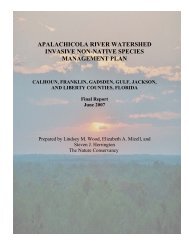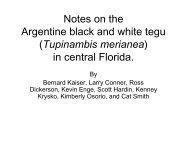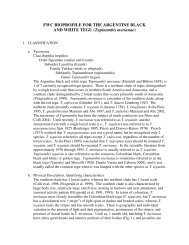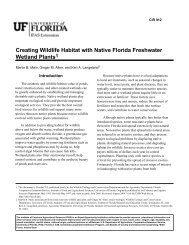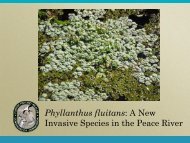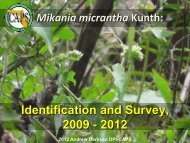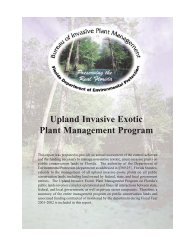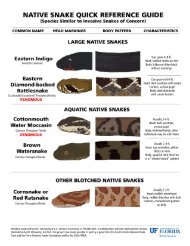Identification Guide For Invasive Exotic Plants of the Florida Keys
Identification Guide For Invasive Exotic Plants of the Florida Keys
Identification Guide For Invasive Exotic Plants of the Florida Keys
Create successful ePaper yourself
Turn your PDF publications into a flip-book with our unique Google optimized e-Paper software.
Scientific Name:<br />
Common Name(s):<br />
Cupaniopsis anacardioides<br />
Carrotwood<br />
Height:<br />
Leaves:<br />
Flowers:<br />
Bark:<br />
Fruit:<br />
O<strong>the</strong>r:<br />
Treatment:<br />
Up to 33 feet<br />
Alternate, compound, with four-12 leaflets that are oblong, lea<strong>the</strong>ry, and<br />
shiny yellowish green. Leaflets can reach eight inches in length and three<br />
inches in width. Tips may be rounded or slightly indented.<br />
Numerous, white to greenish yellow and small. Occur in branched clusters.<br />
Dark gray outer bark and <strong>of</strong>ten orange inner bark.<br />
Woody capsule with three distinctly ridged segments. Fruit ripen in summer,<br />
each about one inch in diameter, yellow to orange in color and divided into<br />
six sections, somewhat resembling a small pumpkin. Seeds are bright red.<br />
Slender evergreen tree capable <strong>of</strong> competing with o<strong>the</strong>r aggressive nonnative<br />
plants such as Brazilian pepper. Tolerant <strong>of</strong> a wide variety <strong>of</strong> extreme<br />
conditions. Invades tropical hammocks, pinelands, mangrove swamps, scrub<br />
habitats and coastal strands.<br />
Basal with 10% Garlon 4 or stump with 50% Garlon 3A<br />
www.co.miami-dade.fl.us/derm/badplants.htm<br />
APIRS- http://aquat1.ifas.edu<br />
21



